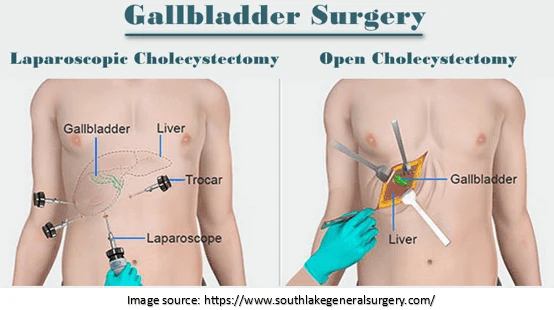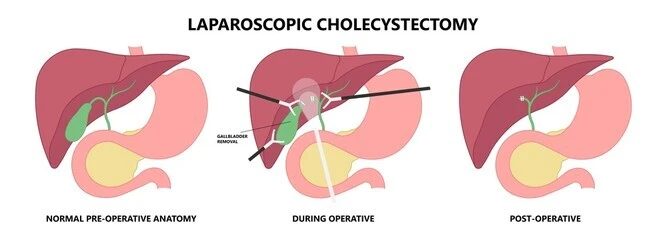Gallstones are a common medical condition affecting millions of people worldwide. They can be extremely painful and significantly affect a person’s quality of life.
While various treatment options are available, including non-surgical methods to dissolve or remove the stones, healthcare professionals often recommend surgically removing the entire gallbladder, known as cholecystectomy. It is a standard procedure performed to address gallstone-related issues effectively.
When diagnosed with gallstones, one may wonder why the solution often involves removing the entire gallbladder (cholecystectomy) instead of just targeting the stones.
In this blog post, we will understand the reasons for removing the gallbladder instead removing gallstones alone.
If you seek gallbladder surgery in Mumbai, Dr. Harsh Sheth is a trusted laparoscopic and robotic gallbladder surgeon. He can provide expert care and address any concerns, including post-surgery pain management.
Traditionally, gallbladder removal was performed through open surgery requiring a large incision. However, laparoscopic or robotic cholecystectomy, a minimally invasive surgical technique, has become the preferred approach. It offers several benefits, including smaller incisions, reduced post-operative pain, faster recovery, and shorter hospital stays.
Dr. Harsh Sheth is a highly-qualified and skilled laparoscopic Gastrointestinal surgeon in Mumbai, specializing in laparoscopic gallbladder surgery. He can accurately diagnose and recommend the most suitable treatment option for your case.
First, let’s understand the difference,

Gallbladder Vs. Gallstones
The gallbladder and gallstones are two distinct entities within the digestive system. The gallbladder is a small, pear-shaped organ located under the liver. Its primary function is to store bile, a fluid the liver produces that helps in fat digestion.
On the other hand, gallstones are small, hard deposits that develop in the gallbladder. It is a pear-shaped organ located under the liver. Gallstones can vary in size and composition, ranging from tiny sand-like particles to larger, pebble-like formations.

Why is there a need to remove gallstones?
- There are several reasons why removing gallstones may be necessary. Firstly, gallstones can cause bloating, nausea, and intense abdominal pain, commonly known as biliary colic. It can be debilitating and recurrent. Gallstone removal may result in severe pain.
- Additionally, gallstones can cause more severe side effects like:
- Cholecystitis (gallbladder inflammation)
- Choledocholithiasis (bile duct blockage)
- Pancreatitis (pancreatic inflammation)
These conditions can be life-threatening if left untreated.
Secondly, gallstones can interfere with the normal flow of bile. It can cause digestive problems and difficulty processing fats.
Finally, recurrent gallstone episodes can significantly affect a person’s quality of life. This can cause discomfort and limit the patient’s ability to engage in daily activities.
Removing the gallbladder alleviates the immediate symptoms. It also reduces the risk of future complications and improves overall digestive health.
Now, let’s understand,
Is it better to remove the gallbladder or gallstones?
- According to Dr Harsh Sheth, a competent laparoscopic gallbladder surgeon in Mumbai, there is no questions about removing only gall stones. It is always advisable to remove the entire gall bladder.
- It is often better to remove the entire gallbladder rather than just targeting the gallstones. This is because gallstones tend to recur over time, and removing the gallbladder eliminates the risk of future gallstone formation and associated complications.
- Additionally, gallbladder removal does not significantly impact digestion or overall health, as the liver can still produce bile that can be redirected into the digestive system.

What can be the Challenges in Treating Gallstones without Removing the Gallbladder?
- Treating gallstones without removing the gallbladder can pose specific challenges. One significant challenge is the high likelihood of gallstone recurrence.
- Even if non-surgical treatments such as medication or shock wave therapy successfully break down the existing stones, new stones may form over time, leading to stone-related complications, such as pancreatitis, cholangitis etc.
- This recurring cycle can lead to persistent symptoms and complications. It may require repeated interventions and potentially impact the patient’s quality of life.
- Additionally, non-surgical treatments may not effectively address all types of gallstones, such as large or calcified stones, making them less suitable for some individuals.
- Medications claimed to dissolve gallstones remain a myth or a fad treatment. No medications can cause dissolution of gallstones once formed.
- As a result, Gallbladder stone operation through cholecystectomy remains a standard and reliable approach for the long-term management of gallstone-related issues.
Advantages of Gallbladder Removal Over Treating Gallstones?
1. Eliminating recurring gallstones:
Removing the gallbladder through cholecystectomy eliminates the risk of future gallstone formation. It provides a more permanent solution to the problem.
2. Relief from symptoms:
Gallbladder removal can alleviate abdominal pain, bloating, and digestive issues associated with gallstone-related complications.
Risks with Removing the Gallbladder Over Gallstones?
1. Surgical risks:
As with any surgery, inherent risks include infection, bleeding, adverse reactions to anesthesia, and a negligible risk (<0.05%) of injury to adjacent organs.
2. Digestive changes:
Some patients may experience digestive changes after gallbladder stone removal, such as diarrhea or an increased risk of bile reflux. However, these effects are usually manageable.
Postoperative Care After Gallbladder Surgery
1. Pain management:
The surgical team will provide pain medication to manage postoperative discomfort. However, with the laparoscopic, and more recently robotic approach to the gall bladder, pain is minimal post procedure.
2. Dietary adjustments:
Gradually reintroduce a regular diet while initially avoiding high-fat or greasy foods (for the first 3-4 weeks).
3. Activity and rest:
Follow the surgeon’s instructions regarding physical activity and rest during recovery. Healthcare professionals often prefer gallbladder removal over treating gallstones. This is because it eliminates recurrent stones and provides relief from associated symptoms.
While there are surgical risks and potential digestive changes, postoperative care and lifestyle adjustments can help individuals recover and lead a normal life without a gallbladder.
When it comes to gall bladder surgery in Mumbai, the expertise and care provided by Dr. Harsh Seth make him an exceptional choice for patients seeking a successful surgical experience.

Frequently Asked Questions
1. What are the signs you need gallbladder removal?
Signs indicating the need for gallbladder removal include recurrent gallstone-related symptoms, such as abdominal pain, bloating, and nausea.
2. What can be the long-term effects of gallbladder surgery?
The long-term effects of gallbladder removal are generally minimal. Some individuals may experience digestive changes, such as loose stools or difficulty digesting fatty foods. However, you can manage these changes with dietary adjustments.
3. Can I eat normally after gallbladder removal?
Most individuals can resume a regular diet 3-4 weeks after gallbladder removal. However, doctors advise avoiding excessive intake of high-fat foods initially (for the first 3-4 weeks) as the body adjusts to the absence of the gallbladder.
4. Can gallbladder removal cause liver problems?
Gallbladder removal itself does not cause liver problems. However, in rare cases, pre-existing liver conditions may be present and require separate management.
5. Can you still get stones after gallbladder removal?
While gallbladder removal eliminates the risk of gallstone formation in the gallbladder, stones can form in the bile ducts or liver (due to other pathologies). However, this occurrence is relatively rare.
6. What size gallstones need surgery?
Gallstones larger than 1 centimetre in diameter or causing symptoms usually require surgical intervention for removal. However, the need for surgery also depends on the individual’s specific situation and symptoms.

